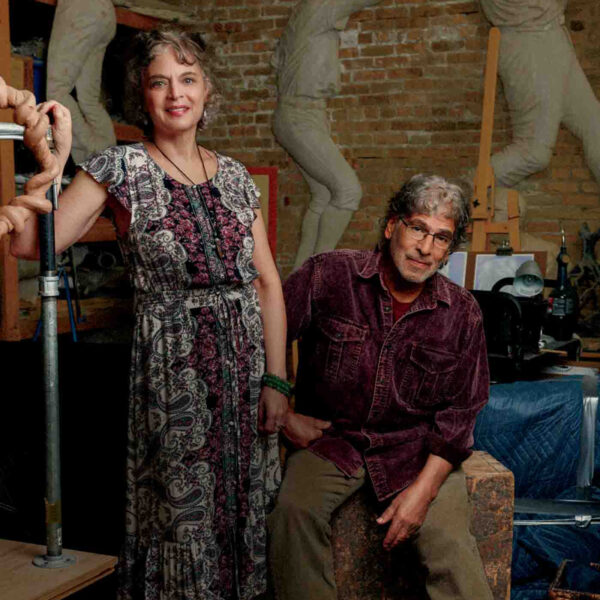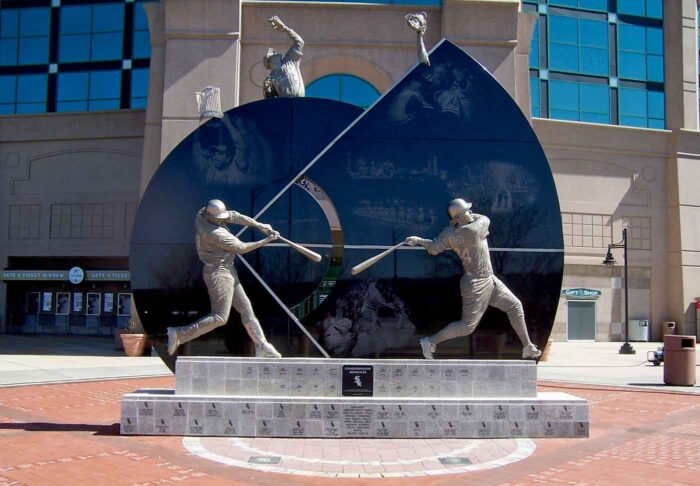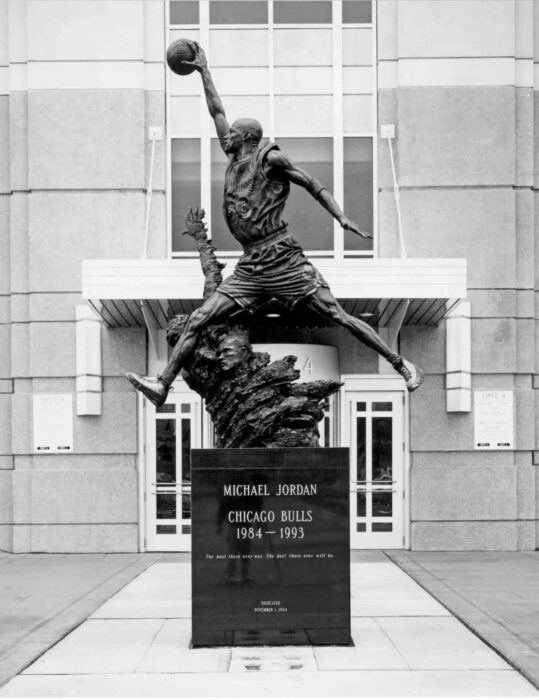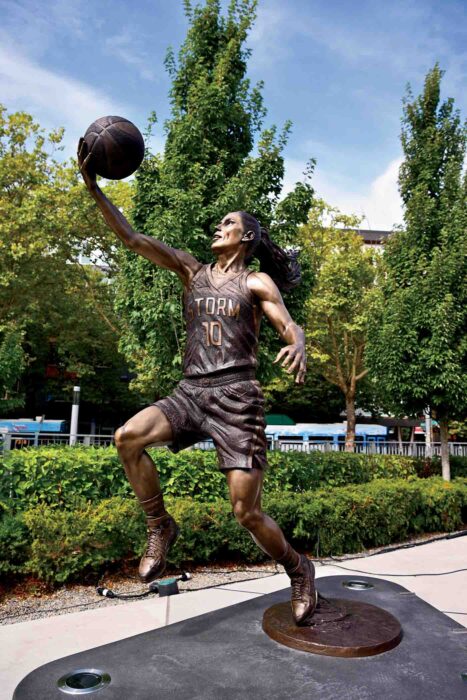THE SHAPE OF ART TO COME
By Joe Rosenthal
PHOTOGRAPHY BY MAGGIE RIFE
STYLING BY THERESA DEMARIA
HAIR & MAKEUP BY LEANNA ERNEST
Artists and founders of Rotblatt Amrany Studio, Julie Rotblatt Amrany and Omri Amrany
By Joe Rosenthal
PHOTOGRAPHY BY MAGGIE RIFE
STYLING BY THERESA DEMARIA
HAIR & MAKEUP BY LEANNA ERNEST
Artists and founders of Rotblatt Amrany Studio, Julie Rotblatt Amrany and Omri Amrany

Despite its cavernous size, the Rotblatt Amrany Studio bristles with a palpable energy. Its resident artists sculpt giant statues of clay that stand 20 or more feet high, coaxing life into the muscles of athletes and emotion into the faces of soldiers. They climb ladders and wield wooden mallets as they work the earthen forms into the recognizable heroes that fill our memories and dreams.
If you’re looking for evidence that energy and passion can take tangible form, look no further than this 30-year-old collective, one of the country’s preeminent sculpture studios. Founders Julie Rotblatt Amrany and Omri Amrany first met in 1985, when they were young artists learning to carve marble in Pietrasanta, an Italian town located just a few miles from the famous Carrara marble quarries and home to Michelangelo in the Renaissance era. Despite the disparate nature of their upbringings—Julie in Highland Park and Omri on a kibbutz in Israel—it was love at first sight for the pair.

“We used to hang out in the same café,” Julie remembers. In the late afternoons, the studios would shut down, and the locals would go home. So, all the visiting artists would settle into the coffee shops and indulge in a glass of wine or an espresso as the sun slowly faded in the Italian sky. It was the sort of dolce vita that inspires both beautiful art and budding romance alike. The couple soon began sketching the idea of an art school on the banks of the Sea of Galilee.
They married and lived together on a kibbutz in Israel for two years, welcoming their son, Itamar. But the Midwest called to the young parents, and Julie wanted to be closer to her family in Chicago. Once stateside, they took odd jobs and taught art to support themselves—Julie at the Art Institute and Omri at the Palette & Chisel Academy of Fine Art. Omri says he had “the Israeli Dream,” but he quickly found his footing in America and took to the Midwest way of life.
In 1992, the pair established a studio and school to mentor emerging artists and soon had hundreds of students. But a 1994 contest to honor Michael Jordan completely changed their career trajectory. Their sketch (which now adorns a wall in the current studio) caught the eye of the Bulls organization and became the winning entry, and the rest, as they say, is history. Located at the United Center, the iconic bronze sculpture, The Spirit, portrays the legendary player soaring through the air, basketball palmed and well out of reach of his opponent.

“That was the first breakthrough, and then more work followed,” Julie recalls. Next up were Harry Caray, numerous Detroit Tigers, Lombardi and Lambeau, George Halas and Apollo 13 astronaut Jim Lovell. And the cadre grew, one and all sprung from the hands of Julie, Omri, and their team of artists and apprentices: Gordie Howe. Ernie Banks. Scottie Pippen. Stan Mikita and Bobby Hull. Kareem and Magic. Physical chemist Rosalind Franklin, A’ja Wilson, Barry Sanders, Kobe and Gianna Bryant, and—most recently—Sue Bird, the first WNBA player to have a statue in her honor. And it wasn’t all statuary: there was the large-scale Veterans Memorial Park in Munster, Indiana, and a triptych painting called Healing Energy for the Kellogg Cancer Care Center at Evanston Hospital, among many others.
“The curriculum and the knowledge were there,” says Omri, recalling all the groundwork that he and Julie had laid in the years leading up to the current studio, one of only two private businesses located in Fort Sheridan.

Above the studio’s active main floor, the plot thickens again. Each new door that’s opened reveals a panoply of works in different media. The gallery space features their personal paintings, sketches, conceptual drawings, castings in stainless steel and other metals, and sculptures of stone. Small, delicate works hang from threads just a few feet from a luminescent bas-relief cast in glass. The gallery is a testament to the diverse and deeply resonant skills of both artists and to those of Itamar, who serves as the Studio Director and is also an artist who works in glass and recently worked on George Lucas’ Lucas Museum of Narrative Arts, opening next year in Los Angeles.
“You know, this is a family. It’s a family business,” says Itamar. In another room, he points out the works of his dad’s family. Omri’s father was a woodworker and ceramicist, and his grandmother wove traditional decorative containers. “My great-grandmother wove those in Israel,” says Itamar. “They are out of papyrus; we have huge pieces at home like this,” echoes Julie.
Looking at the thriving studio, and the community and culture they have built, it’s evident that the Rotblatt Amrany family extends across time, generations, and nations.
“It’s about developing culture. That’s ultimately our goal. We want to create a culture of the arts in the community. Our studio and our neighbors, the Midwest Young Artists Conservancy, have a vision for that within Fort Sheridan,” says Itamar, explaining that Rotblatt Amrany intends to create a sculpture garden while the conservancy has plans for a Symphony Center within the wooded, parklike Fort Sheridan neighborhood.
The family aims to create a space that nurtures health, happiness, and human connection, to improve quality of life. And while their art is grounded in practices that are thousands of years old, they are looking ahead to the future—embracing technologies like AI and innovative materials as ways to advance their field and expand the influence of their work. The craft may be advanced by technology, but as Julie puts it, there’s more to art than the craft.
“As an artist, I value the craft and the concept,” she says. “The concept of having your creation be more philosophical, facing or challenging bigger questions in life.”
Reflecting on the famous Jordan statue that so dramatically impacted the studio’s fate, Itamar says it comes down to more than rendering realistic shapes. “Michael is the spirit. The whole concept is Michael’s essence, the spirit of Air Jordan, and capturing the anti-gravity notion that people all know him as this flying, dynamic athlete.”
Looking at what the Rotblatt Amrany team has built over the past several decades, the same can be said of them. Their budding empire captures nothing if not the spirit of dynamic artists at work.
To speak with the studio team about a commission or to view the online gallery, visit rotblattamrany.com.
Sign Up for the JWC Media Email